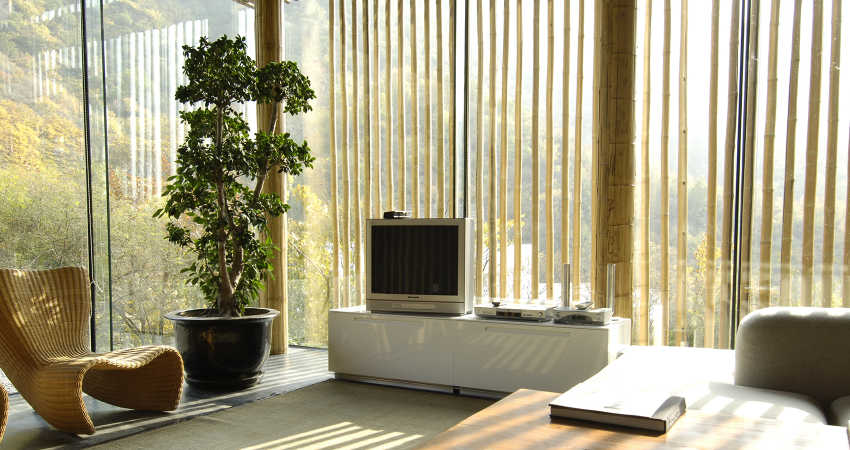
Bamboo – a ‘green’ option for housing
In India, the early bamboo architecture laid the foundation of the dome-shaped Mughal constructions including the Taj Mahal. Recently, India has seen a swelling demand for use of bamboo in the construction industry, leading to better economic conditions especially in the rural areas. Also the dynamics of supply chain management would see a change with increasing opportunities for small players and start-ups.
Increasing Business Opportunities for Entrepreneurs
The paper and pulp industry consumes 35% of the bamboo grown in India followed by housing at 20%. The National Mission on Bamboo Technology and Trade Development has assessed the demand for its various applications as 27 million tonnes against the availability of 13.47 million tonnes. The size of existing bamboo economy is estimated as Rs.2043 Cr. as against the market potential of Rs.4463 Cr. The projected annual average growth rate of 15-20% it is expected to reach Rs.26000 Cr by 2015.
Entrepreneurs must exploit this opportunity and use this natural resource to meet the increasing need for housing and growing pressure on land.
Bamboo could substitute as the main load bearing element in construction
Field visits to the rural areas of Jharkhand reveal that Bamboo is primarily used as load distributors on roofs with timber as the main load bearing element. Due to the long gestation period of trees and growing concern for deforestation, availability of timber poses a threat. With the spurring of construction activities in the rural areas under Sarva Shiksha Abhiyan (SSA), Indira Awas Yojna and the likes, it is imperative that entrepreneurs at the grass-root level look into local materials to sustain such activities. Hence there is a need to investigate if bamboo could substitute as the main load bearing element.
Land degradation & acute shortage of bricks
Our interaction with Jharkhand Education Project Council (JEPC) officials also revealed that there is an acute shortage of bricks in the district of Ranchi itself so much so that the requirements of bricks for construction work under the Sarva Shiksha Abhiyan is becoming increasingly difficult to meet. Against a requirement of 2,79,78,200 bricks in a year, the total availability in the district is 2,76,00,000 bricks. Thus if we take into account the demand for SSA alone the shortfall is to the extent of 378200. One brick requires 0.0204 cubic metres of soil, totalling to a requirement of 570755 cubic metres per year to meet the requirements of SSA alone. This has implications in terms of land degradation too.
Addressing global warming
Growing concern over the impact of increasing Green House Gas (GHG) emissions on world climate has prompted the world community to address this pressing environmental problem, thus the Energy Building Code 2007, was introduced as one of the measures. Bamboo is not only the World’s fastest and the strongest growing woody plant but is also an enduring, versatile and highly renewable resource. Its adaptability to different climatic conditions makes it one of the most important species for mitigation of the climate change. It has been reported that ‘Phylostachys bambusoides’ in Kyoto, Japan, has a carbon sequestration potential of around 2 tonnes per hectare. Agro-forestry has been found to be the most cost effective method of addressing the carbon emission and consequent global warming issues. By going for shorter gestation period species like bamboo, can be used as an effective mitigation option through carbon sequestration.
An eco-friendly housing option
Bamboo construction is also an attractive business area as customers are showing interest in eco-friendly products and the government is also looking for substitutes of timber so that the forest cover is protected. National Mission on Bamboo Applications (NMBA) was set up with a budget outlay of Rs.100 crores in 2004. Its core aim is to promote bamboo based products. Using bamboo for housing purpose is an eco-friendly option. When bamboo is used in houses then the carbon remains locked in the bamboo till the duration of the structure. The lesser the processing, lesser the energy consumption. The use of bamboo parabolic arches as load bearing elements is thus a ‘green’ option for housing, a growing opportunity for green entrepreneurs!
About the author: Smita Chugh is a ‘Doctoral Research Student, Centre for Rural Development and Technology, Indian Institute of Technology, Delhi’.

Abhijit and Gaurav Parashar, ECPS India
Abhijit and Gaurav, entrepreneurs from premiere institutes – IIM and IIT, are motivated with a cause. Their drive to discover and implement sustainable environment solutions finds its roots in their student years. The promoters have a long background in climate change mitigation programs and campaign. As Gaurav puts it, “I am the founder of Delta Climate – the first campus sustainability program which is an enabling means to convert the IIT campuses sustainable; and Indian Youth Climate Network (IYCN) – a nationwide youth network of climate change activists. I have had long term interactions with groups like the Clinton Climate Initiative, 350.org and understood the dynamics of the green market. We have realized a lot of spaces where IT can automate processes and make them more efficient.”
ECPS was founded out of a considerable need gap analysis between the currently existing audit and consulting model which lacks in providing complete solutions to the Energy and Carbon needs of a firm.
The focus of ECPS
Abhijit and Gaurav have identified four key focus sectors, which are critical to solving the energy and climate crisis in the coming decade. These are smart motor systems, intelligent logistics, improved building technology and smarter grids. Talking about the enterprise, they add, “ECPS is strategically positioned to serve the market gap unfilled by the conventional consulting model which is unable to serve the non compliance energy and carbon markets, in particular. We believe that technology has the power to complement what consultants and auditors are doing in this market, in a more efficient and cost effective manner. Also, automating solutions gives us a big competitive edge in terms of scalability and customer loyalty over any on-site model.”
Challenges and hurdles
Just like any other enterprise, these young entrepreneurs have faced and overcome various operational and technical hurdles. In their entrepreneurial venture, the duo has consulted many mentors and guides, so as to make the most of their experience and fresh perspective. Abhijit, 23 and Gaurav, 20 confidently talk about their journey so far, “We are a start-up of students, with work experience in varied fields. We have had to work our way out to run ECPS along with our curriculum at IIT’s and IIM. We have to be very efficient in managing time so as to strike a perfect balance between work and the academics and coordinate well with the system. While building our product we have to be specific about providing high quality custom solutions. To overcome these problems, we have always worked as a team, understood the problem at its core and work towards the solutions in a systematic manner.
For operational issues, we have always been helped by the Entrepreneurship Cell, IIT Bombay and the Society for Innovation and Entrepreneurship (SINE), IIT Bombay. We have always found our solution by brainstorming and discussion. For technical problems, we always have the luxury to consult our Professors at IIT Bombay and IIM Bangalore. We also are in touch with a network of technical professionals; we work with them on an informal basis.”
USP for the clientele
ECPS offers an out-of-the-box and smart IT solution to fulfill the energy and carbon efficiency needs of the clients. The enterprise mostly has corporate clients who use their software and products on a recurring basis. Gaurav discusses, “ECPS provides solutions which supersede the current offerings in the market. Our USP includes the following:
- Cost cutting potential
- Branding advantages
- Corporate valuation and Investor requirements
- CSR and corporate sustainability
- CDM potential
Our current revenue model of ECPS is based on recurring revenue, based on the services offered to our clients. We operate as a Software-as-a-service (SAAS) model. ECPS would stick to the same revenue model for the next couple of years.”
Message to the youth of India
Gaurav sums up all his lessons and experiments with entrepreneurship quite precisely in his message to the emerging entrepreneurs of India, “I have always believed that one can pursue his/her goals and aspirations with hard and smart work. To all the potential entrepreneurs in India, I would like to say – be sure about what you want to do and how you would do it and once you have made up your mind, hold no bars. The world is yours! It is a very good time to be India – to enable the lives of millions with your enterprise. The future looks very bright to me.”
In an interview with Abhijit and Gaurav, founders of Energy and Climate Productivity Solutions (ECPS), Unnati Narang explores the intricacies of their product based technology firm focused on providing smart IT solutions to the clean technology sector in emerging markets.

